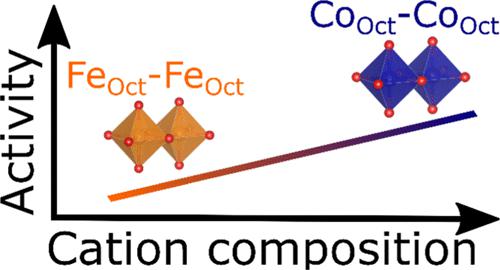当前位置:
X-MOL 学术
›
J. Phys. Chem. C
›
论文详情
Our official English website, www.x-mol.net, welcomes your
feedback! (Note: you will need to create a separate account there.)
Atom Pair Frequencies as a Quantitative Structure–Activity Relationship for Catalytic 2-Propanol Oxidation over Nanocrystalline Cobalt–Iron–Spinel
The Journal of Physical Chemistry C ( IF 3.3 ) Pub Date : 2022-06-16 , DOI: 10.1021/acs.jpcc.2c00788 Jeremias Geiss 1, 2 , Tobias Falk 3 , Stevan Ognjanovic 1, 2 , Sven Anke 3 , Baoxiang Peng 3, 4 , Martin Muhler 3, 4 , Markus Winterer 1, 2
The Journal of Physical Chemistry C ( IF 3.3 ) Pub Date : 2022-06-16 , DOI: 10.1021/acs.jpcc.2c00788 Jeremias Geiss 1, 2 , Tobias Falk 3 , Stevan Ognjanovic 1, 2 , Sven Anke 3 , Baoxiang Peng 3, 4 , Martin Muhler 3, 4 , Markus Winterer 1, 2
Affiliation

|
The purpose of this study is to find a direct and quantitative correlation of the structure of Co3−xFexO4 nanoparticles with catalytic performance in 2-propanol oxidation. Eight nanocrystalline samples with varying iron contents are synthesized, and quantitative information regarding their structure is obtained from nitrogen physisorption, X-ray diffraction (XRD), X-ray absorption near-edge structure (XANES), and extended X-ray absorption fine structure (EXAFS) analyzed by reverse Monte Carlo simulations. The catalytic performance is tested in 2-propanol oxidation in the gas phase. Overall, catalytic conversion data as a function of temperature are deconvoluted to obtain conversion and half-conversion temperatures as quantitative parameters for the different catalytic reaction channels. The crystal structure is described by a spinel structure with interstitial cation defects. These defects result in a reduced electronic state of the nanoparticles. The defect density depends on the cationic composition. We also observe a complex cationic distribution on tetrahedral and octahedral sites, which is strongly influenced by the overall cationic composition. In the catalytic tests, the samples exhibit a low-temperature pathway, which is deactivated in subsequent runs but can be recovered by an oxidative treatment of the catalyst. We find that the frequency of cation pairs CoO–CoO and CoO–CoT of the individual samples correlates directly to their catalytic activity and selectivity.
中文翻译:

原子对频率作为纳米晶钴-铁-尖晶石催化 2-丙醇氧化的定量构效关系
本研究的目的是找到 Co 3− x Fe x O 4结构的直接和定量相关性纳米粒子在 2-丙醇氧化中具有催化性能。合成了 8 个不同铁含量的纳米晶样品,并通过氮物理吸附、X 射线衍射 (XRD)、X 射线吸收近边结构 (XANES) 和扩展 X 射线吸收精细结构获得了有关其结构的定量信息(EXAFS) 通过反向蒙特卡罗模拟分析。在气相中的 2-丙醇氧化中测试催化性能。总体而言,作为温度函数的催化转化数据被解卷积以获得转化和半转化温度作为不同催化反应通道的定量参数。晶体结构由具有间隙阳离子缺陷的尖晶石结构描述。这些缺陷导致纳米粒子的电子状态降低。缺陷密度取决于阳离子组成。我们还观察到四面体和八面体位点上的复杂阳离子分布,这受到整体阳离子组成的强烈影响。在催化测试中,样品表现出低温通路,该通路在随后的运行中失活,但可以通过催化剂的氧化处理来恢复。我们发现阳离子对的频率 Co单个样品的O -Co O和 Co O -Co T与它们的催化活性和选择性直接相关。
更新日期:2022-06-16
中文翻译:

原子对频率作为纳米晶钴-铁-尖晶石催化 2-丙醇氧化的定量构效关系
本研究的目的是找到 Co 3− x Fe x O 4结构的直接和定量相关性纳米粒子在 2-丙醇氧化中具有催化性能。合成了 8 个不同铁含量的纳米晶样品,并通过氮物理吸附、X 射线衍射 (XRD)、X 射线吸收近边结构 (XANES) 和扩展 X 射线吸收精细结构获得了有关其结构的定量信息(EXAFS) 通过反向蒙特卡罗模拟分析。在气相中的 2-丙醇氧化中测试催化性能。总体而言,作为温度函数的催化转化数据被解卷积以获得转化和半转化温度作为不同催化反应通道的定量参数。晶体结构由具有间隙阳离子缺陷的尖晶石结构描述。这些缺陷导致纳米粒子的电子状态降低。缺陷密度取决于阳离子组成。我们还观察到四面体和八面体位点上的复杂阳离子分布,这受到整体阳离子组成的强烈影响。在催化测试中,样品表现出低温通路,该通路在随后的运行中失活,但可以通过催化剂的氧化处理来恢复。我们发现阳离子对的频率 Co单个样品的O -Co O和 Co O -Co T与它们的催化活性和选择性直接相关。











































 京公网安备 11010802027423号
京公网安备 11010802027423号